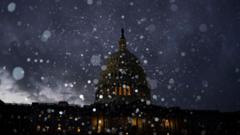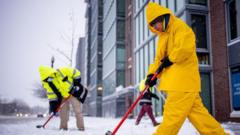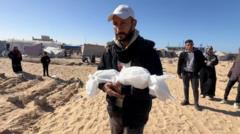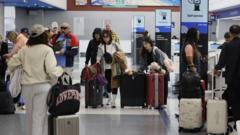As a significant winter storm approaches, tens of millions throughout the United States are preparing for what could potentially be the most substantial snowfall and lowest temperatures experienced in a decade. The National Weather Service (NWS) has reported that the storm originated in the country’s midsection and is projected to move eastward in the upcoming days. Regionally, states such as Mississippi and Florida, typically unaccustomed to severe winter conditions, have been issued warnings about the impending hazardous weather.
**Severe Winter Storm Set to Transform US Weather Landscape**

**Severe Winter Storm Set to Transform US Weather Landscape**
A massive winter storm is poised to sweep across the US, bringing unprecedented snow and frigid temperatures in over ten years.
The cold snap is being attributed to the polar vortex, an area of intense cold air circulating around the Arctic. The National Oceanic and Atmospheric Administration has indicated that "for some, this could be the heaviest snowfall in over a decade." Weather experts at AccuWeather have highlighted the possibility of this January becoming the coldest experienced in the US since 2011, with temperatures expected to plummet significantly below historical averages for an extended period.
As the storm progresses eastward, the eastern seaboard is expected to be impacted by Sunday evening, with considerable disruption anticipated in the central US. Forecasts predict "dangerous or impossible driving conditions and widespread closures" continuing into the weekend. Areas in Kansas and Indiana could experience at least 8 inches (20.3 cm) of accumulated snow, while blizzard conditions may manifest in parts of the Midwest. The NWS warns of potential whiteout conditions leading to extremely dangerous travel, further complicating matters for motorists.
In addition to snowfall, sleet and freezing rain are expected to affect regions in Missouri, Illinois, Kentucky, and West Virginia as the storm advances. Cities such as Washington D.C., Baltimore, and Philadelphia are preparing for a weekend of icy conditions, with a forecast of accumulating snowfall ranging between 5-12 inches in parts of Virginia.
Meanwhile, parts of the southern US, including Arkansas, Louisiana, and Mississippi, may face severe thunderstorms this Sunday. Meteorologist Ryan Maue described the situation as "a potential disaster," noting that the severity of these weather conditions is unprecedented in recent years.
Due to the anticipated flight disruptions caused by the storm, major airlines including American, Delta, Southwest, and United are waiving change fees for passengers affected by the severe weather in order to assist travelers.
As the storm progresses eastward, the eastern seaboard is expected to be impacted by Sunday evening, with considerable disruption anticipated in the central US. Forecasts predict "dangerous or impossible driving conditions and widespread closures" continuing into the weekend. Areas in Kansas and Indiana could experience at least 8 inches (20.3 cm) of accumulated snow, while blizzard conditions may manifest in parts of the Midwest. The NWS warns of potential whiteout conditions leading to extremely dangerous travel, further complicating matters for motorists.
In addition to snowfall, sleet and freezing rain are expected to affect regions in Missouri, Illinois, Kentucky, and West Virginia as the storm advances. Cities such as Washington D.C., Baltimore, and Philadelphia are preparing for a weekend of icy conditions, with a forecast of accumulating snowfall ranging between 5-12 inches in parts of Virginia.
Meanwhile, parts of the southern US, including Arkansas, Louisiana, and Mississippi, may face severe thunderstorms this Sunday. Meteorologist Ryan Maue described the situation as "a potential disaster," noting that the severity of these weather conditions is unprecedented in recent years.
Due to the anticipated flight disruptions caused by the storm, major airlines including American, Delta, Southwest, and United are waiving change fees for passengers affected by the severe weather in order to assist travelers.








